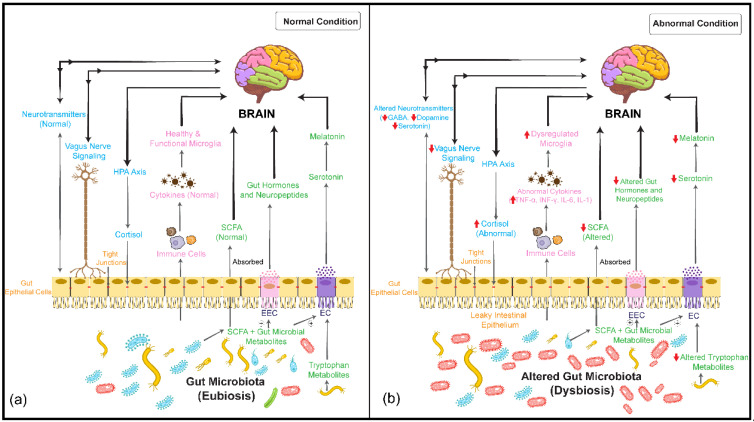Figure 1.
(a) Potential pathways involved in the communication between the gut microbiome and brain (microbiota–gut–brain axis, MGBA). (b) Alterations in gut microbiome (dysbiosis) and MGBA communication in neurodegenerative disorders. Gut microbiome–brain communication occurs mainly via three pathways: (1) neural (vagus and enteric nervous system, neurotransmitters, blue letters), (2) immune (cytokine balance and functional microglia, pink letters), and (3) humoral/metabolic (gut hormones, short-chain fatty acids (SCFAs), and neuropeptides, green letters). Neural communication is established via the vagus nerve and the hypothalamic–pituitary–adrenal (HPA) axis and systemic communication via the immune and humoral/metabolic pathways. In neurodegenerative disorders, the composition and activity of the normal gut microbiome are altered, leading to abnormal microbial metabolite profiles such as altered levels of neurotransmitters and SCFAs. The result is disruption of the neural, immune, and humoral/metabolic pathways and increased risk for disease progression [12,17,19]. The red arrows indicate alterations during dysbiosis ( activation/upregulation,
activation/upregulation,  inhibition/downregulation). EC: enterochromaffin cell; EEC: enteroendocrine cell; SCFA: short-chain fatty acid; HPA: hypothalamus–pituitary–adrenal; TNF-α: tumor necrosis factor-α; INF-γ: interferon gamma; IL-6: interleukin-6; IL-1: interleukin-1; GABA: gamma-amino butyric acid. ⊕: stimulates/promotes.
inhibition/downregulation). EC: enterochromaffin cell; EEC: enteroendocrine cell; SCFA: short-chain fatty acid; HPA: hypothalamus–pituitary–adrenal; TNF-α: tumor necrosis factor-α; INF-γ: interferon gamma; IL-6: interleukin-6; IL-1: interleukin-1; GABA: gamma-amino butyric acid. ⊕: stimulates/promotes.

